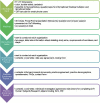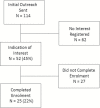Recruiting primary care practices for practice-based research: a case study of a group-randomized study (TRANSLATE CKD) recruitment process
- PMID: 28985294
- PMCID: PMC6454459
- DOI: 10.1093/fampra/cmx064
Recruiting primary care practices for practice-based research: a case study of a group-randomized study (TRANSLATE CKD) recruitment process
Abstract
Background: We assessed the challenging process of recruiting primary care practices in a practice-based research study.
Methods: In this descriptive case study of recruitment data collected for a large practice-based study (TRANSLATE CKD), 48 single or multiple-site health care organizations in the USA with a total of 114 practices were invited to participate. We collected quantitative and qualitative measures of recruitment process and outcomes for the first 25 practices recruited. Information about 13 additional practices is not provided due to staff transitions and limited data collection resources.
Results: Initial outreach was made to 114 practices (from 48 organizations, 41% small); 52 (45%) practices responded with interest. Practices enrolled in the study (n = 25) represented 22% of the total outreach number, or 48% of those initially interested. Average time to enroll was 71 calendar days (range 11-107). There was no difference in the number of days practices remained under recruitment, based on enrolled versus not enrolled (44.8 ± 30.4 versus 46.8 ± 25.4 days, P = 0.86) or by the organization size, i.e. large versus small (defined by having ≤4 distinct practices; 52 ± 23.6 versus 43.6 ± 27.8 days; P = 0.46). The most common recruitment barriers were administrative, e.g. lack of perceived direct organizational benefit, and were more prominent among large organizations.
Conclusions: Despite the general belief that the research topic, invitation method, and interest in research may facilitate practice recruitment, our results suggest that most of the recruitment challenges represent managerial challenges. Future research projects may need to consider relevant methodologies from businesses administration and marketing fields.
Trial registration: ClinicalTrials.gov NCT01767883.
Keywords: PBRN; practice recruitment; practice-based research; primary care; recruitment barriers.
© The Author 2017. Published by Oxford University Press. All rights reserved. For permissions, please e-mail: journals.permissions@oup.com.
Figures
References
-
- Voorhees JR, Xierali IM, Bazemore AW et al. . A small percentage of family physicians report time devoted to research. J Am Board Fam Med 2013; 26: 7–8. - PubMed
-
- Mold JW, Lipman PD, Durako SJ. Coordinating centers and multi-practice-based research network (PBRN) research. J Am Board Fam Med 2012; 25: 577–81. - PubMed
-
- Sahin D, Yaffe MJ, Sussman T, McCusker J. A mixed studies literature review of family physicians’ participation in research. Fam Med 2014; 46: 503–14. - PubMed
-
- Fulda KG, Hahn KA, Young RA et al. . Recruiting Practice-based Research Network (PBRN) physicians to be research participants: lessons learned from the North Texas (NorTex) needs assessment study. J Am Board Fam Med 2011; 24: 610–5. - PubMed
Publication types
MeSH terms
Associated data
Grants and funding
LinkOut - more resources
Full Text Sources
Other Literature Sources
Medical



